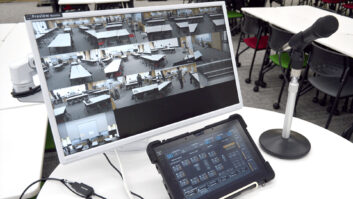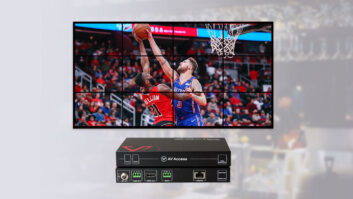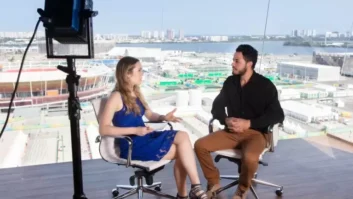
Courtroom Audio and Video, Part 1
Aug 12, 2010 2:12 PM,
With Bennett Liles
Listen to the Podcasts
|
Editor’s note: For your convenience, this transcription of the podcast includes timestamps. If you are listening to the podcast and reading its accompanying transcription, you can use the timestamps to jump to any part of the audio podcast by simply dragging the slider on the podcast to the time indicated in the transcription.
Related Links

Courtroom Audio, Video, and Control, Part 2
The Minnesota Supreme Courts called in MSpace for its recent installation. …
Keeping order in the court at the Minnesota Supreme Court has become, in part, the job of a new sound system and voice activated video system upgrade. They called in MSpace for the job and sales engineer Tom Larson is going to give us all the behind-the-scenes tech details.
Tom thanks for being with me here on the SVC podcast from all the way up there in Minnesota, the Minneapolis area I believe.
Yep, Minneapolis, Minn. Actually we’re in a suburb of Minneapolis called Minnetonka. [Timestamp: :58]
All right, I have heard of that. And MSpace is the company. What does MSpace do? Obviously you’re into some pretty heavy-duty AV integration, but what kind of jobs does the company take on?
Well, MSpace is involved a number of various of AV integration. A core of our business is in both corporate America and also government and education. We do a lot of training rooms, a lot of boardrooms, conference rooms; we also do courtrooms and then we get into some classrooms, some distance education, but again, corporate America and our core confidency is really in videoconferencing and audioconferencing. That’s always been an expertise of ours. And then recently we acquired Fox River Graphics out of Carpentersville, Ill., and with them, we also now have a GSA contract, which we’re enjoying the leverage and hospilities with that. [Timestamp: 1:55]
OK and it’s not hard to see then why you were chosen to do the sound and video system upgrade at the Minnesota Supreme Court. And you have some people in there considering some very weighty matters and you don’t want the AV system slowing things down or bringing attention to itself. So what was the situation in the courtrooms there and what did they want to change when they brought MSpace in?
First of all, there were three rooms that we did for the Minnesota Supreme Court. One was the largest Supreme Court courtroom. There were also two additional rooms for the Court of Appeals and all three of those rooms had the similar problem in that they had very old microphone technology in there. The microphones were old, the system mixers that were in there were old, and everything needed to be upgraded. The audio quality that they were getting on the record was poor, and there was just a point where system was not proving useful for both the record and for the other purposes they had in the room. And in the Courtroom 300 specifically—that’s the room that belongs to the Minnesota Supreme Court—in that room, the audio is used for some speech reinforcement, but it’s also used for the record; it is also used for feeds to the press and for streaming out as the Minnesota government decides they want to stream out those hearings, and so the audio service has a multitude of functions in that room, and it was very much time for an upgrade. [Timestamp: 3:26]
Now do they use the video there for archiving—I guess there’s an aspect of that—or broadcast?
The video in that room goes down to a main room where they have a number of splits that the press can tie into, and one of the feeds from that press area goes out to a streaming server that the government owns and runs so then if they want to archive that, that’s something that they have the ability to do. And frankly, we provided the feed to that, but we didn’t provide the streaming technology—that’s something they already had in place. [Timestamp: 4:05]
Now are you pretty much the go-to guy on the design of what they wanted to upgrade here?
I worked with sales person John Kast, and he’s our government sales person in education, and John brought me in with him to look at the room and look at the opportunity. Between him and I, we came up with what was going to be a good solution for what they needed to do. [Timestamp: 4:31]
And why did you decide to go with the Vaddio switcher and camera system?
Well, MSpace has a great history with Vaddio. Some of us use to work for a company called Acoustic Communications before that and also another company called ClearOne Communications, and Rob Sheeley who was with Vaddio was strong part of that. So we’ve always enjoyed some synergy with Vaddio. Their products are very good and they also have a price point that is very competitive, especially when you’re putting something into an installation that tax payers are going to be paying into. It’s a nice thing to provide some value there and Vaddio provides a great quality to value ratio.
And one thing I would mention at this time is that we have a lot of the technology that we did in this installation and that we’re talking about today is going to be represented at our Education Series and Technology Showcase that we have coming up. It’s going to be called MSpace University, here on August 25th, and I would plug that. You could go to our website, which is www.yourmspace.com for more information on that event or you can RSVP to come to it. And we’ve got some great classes there and a number of the vendors, including Vaddio, that we used in this installation are going to be there and they’re going to be showing off the latest and the greatest of what they’ve got. [Timestamp: 5:59]
Sounds like the kind of thing you’ll want to make time to do for sure. I wanted to jump back into the audio thing for a minute. This is a courtroom, so where are the mics located in here and how are they controlled?
The Supreme Court is very much like a council chamber in that the Supreme Court sits in a semi-circle at the front of the room. There’s a little wraparound, so they’ve got the ability to look at one another as well as looking at someone that may pleading an argument out at the front of the room. Each of the justices sitting around the semi-circle has their own microphone. In addition, there’s a microphone that’s on a lectern at the front of the room facing the justices where attorneys and people are able to present their arguments to the court. But I believe we also we have a microphone that is at the clerks plate as well so that the clerk, if there’s something that they need to instruct that they’re able to make those comments as well. [Timestamp: 7:01]
OK and you went with Audio-Technica mics.
Yeah, we ended up using a MicroLine series microphone from Audio-Technica. Out at the lectern we used a longer microphone which is an 18 in. microphone, and if you’re familiar with the MicroLine, the MicroLine element itself is about 5in. long so that actually becomes quite a long microphone—about 24in., but that actually can facilitate either a short stature or very tall stature presenter out at that location. Then at each of the justice locations we used the Audio-Technica, it was an ES935, which is a smaller 6in. microphone and that’s actually attached to a custom plate that we had designed, and the reason that we went with the MicroLine microphones as opposed to another is because of the polar pattern of the MicroLine is hypercardioid mini-shotgun, if you will, microphone. So it’s able to reach back toward that justice who, as arguments may go on, they may choose to sit back in their chair and relax a little bit and you want to have that microphone have some reach to get towards the conversation. If a justice makes a comment to the plaintiff or the other justices in the room they want to be heard both for the record and to the room and that microphone has proven to do that job very well for us. [Timestamp: 8:35]
1
Courtroom Audio and Video, Part 1
Aug 12, 2010 2:12 PM,
With Bennett Liles
Yeah and maximum gain before feedback I guess for the tight pattern.
You’ve got that, and if the justices decide that they want to push the microphone out of the way it does eliminate that. Now I would have to say that the panels that we had custom built for this also have an integrated mute switch on there so we’re hoping that the training that we provided for the justices using this system will have them using that mute switch more than shoving the microphone to the side, but some people, they seem to be prone that if they didn’t want them to hear it they just shove it to the side. Well that pattern will have at least have less audio commune off access. [Timestamp: 9:15]
Well, at least they can’t get to the cameras and shove those out of the way. And you created a voice activated system with camera control.
That is correct and that was one of the things you asked, why we went with Vaddio, and that is certainly one of the main reasons that we went with Vaddio. We’re very, very familiar and comfortable with some of the products that Vaddio had, and at the time that we did this installation, we chose to use their ProductionView FX, which is a camera controller, and the way that the cameras were laid out in the room, there was a camera that was mounted in a panel directly above and behind the justices and behind the little piece of the Plexiglas so it blends into the environment and is unnoticeable, but that back camera is trained on a presenter presenting their oral arguments to the justices. Then at the rear of the room in the back two corners also hidden behind Plexiglas mounted very high in the ceiling are two additional Vaddio WallView Pro300 PTZ cameras and all three of those cameras then connect into this ProductionView and the ProductionView can be controlled manually by an operator down, actually, in the basement of the building. There’s a small screen on there for preview so they can line up whoever is speaking and they can control that shot. But each of the cameras has built-in presets as well, and the way that we ended up using that was basically taking certain presets and having whenever someone chooses to speak, one of the justices speak, the camera that is assigned to that particular justice and their microphone will pick up that justice or maybe that justice and the justice on either side so as it’s not distracting and automatically focus on the person speaking. So it works very smoothly; there’s also some transitioning that happens in the ProductionView so when the camera switches from one camera to another that that transition happens smoothly and it’s not a real jarring effect to somebody who might be watching the stream or watching the video feed. [Timestamp: 11:27]
Yeah, I saw some of the pictures of those cameras. You can barely see them back there in the Plexiglas, and I guess that’s a good thing because they’re moving around all the time in response to who’s talking and I guess that in itself might tend to draw attention to the cameras.
They might be, although the WallView 300s are a fairly quiet camera. You wouldn’t hear a lot of noise, so I would imagine unless you were really paying attention, you probably wouldn’t notice. But even so, in a room that’s elegant like the Minnesota Supreme Court, it’s best to just keep that behind glass and then you’re really not paying attention to them. [Timestamp: 12:05]
And you’ve got automatic mic mixing there and that triggers the cameras. How does that interface take place with the cameras responding to the mics?
We ended up using the Biamp Nexia system and we use Biamp products. We use ClearOne products. We’re comfortable in either format, but in this particular case, we ended up going with the Biamp Nexia product partially for value and partly because we really needed to have the ability to write a custom program so that the audio would trigger RS-232 commands that would trigger presets in those cameras. So we used essentially Nexia TC and VC boxes for the microphone inputs, but then we also used the Biamp Logic Box and we take Logic outputs from the microphone. The Logic inputs will then trigger in the Biamp essentially presets when, let’s say the chief justice is speaking. It will trigger a preset that will go to the camera to preset 1, which focuses on the chief justice and that can happen automatically whenever that justice is speaking. One of the things the court told us is that while they want to have the ability to have someone sit there and run the room in, say, a high-profile case so that they can get exactly the video that they want to see at any given point, most of the time the room is going to be in an auto mode where it’s going to be running itself. And between the Vaddio ProductionView and the Biamp talking with one another, they were able to do just that and we’re doing that without any third-party control system and the products are just talking between the Biamp and the Vaddio without a Crestron or an AMX, which is a unique thing but it also comes back to a point of value for the room. [Timestamp: 13:50]
Yeah, that’s a thing of wonder when you finally get it all hooked up and you see it work for the first time and it does what it is supposed to do—part of which in this case is not to be noticed at all by the users. So you had to pull a good bit of cable on this thing. I read somewhere that you used a vacuum bag or something to get the cable through.
Yeah, we had some brilliant and inventive technicians on this. Our lead technician is a gentleman named Brian Green, and we also had another technician, Steve Walberg, who is our Biamp Nexia audio programmer, but he’s also a phenomenal field installer, and between the two of them, they ended up having to come up with some rather unique and clever ways of getting cable pulled through the system. What happened is “as the crow flies” the equipment rack and the room were maybe 50 yards away from one another or closer, as the conduit in the building is laid out. Well we really don’t know because there were no documents in the building of the architectural structure, but the two buildings were separated by some bridge and walkways, and there were probably six or more right angle bends that happened in this path that probably ends up getting around the 200 yard mark by the time it went from one point to the other. And the pipes were old and there was some corrosion in there and the cable was not pulling through. At one point the guys, yes, literally ended up putting a vacuum bag or a vacuum on one end and a plastic bag over the end of the cables and literally ended up sucking them through the conduit. Certainly by the time we pulled the whole bunch of cables through that conduit it was jam packed. Certainly, people take cable pulling for granted sometimes, but that was certainly one of the greatest challenges of the whole project was just figuring out how we were getting the cables from point A to point B. And it should be said that the old cables were there. We did use some of those old cables as upholstering, but at some point, the jackets on them were so old that the cables were breaking in the pipe when we tried to pull the old cables out. So it was one of those cases where hats off to some great field technicians. [Timestamp: 16:24]
Well, that was a pretty inventive way of handling the not-so-glamorous aspect of the installation.And you had the mics connecting through Logic boxes. Who made those?
The microphones were the Audio-Technica microphones, and they were, again, connected to the Logic box. Now, we did have some custom plates that we had installed in front of each of the justices as well the lectern where somebody’s presenting their whole arguments and the clerk and those were made for us by the D’San Corporation. And that was the interface point, but it was the Audio-Technica microphones interfacing with the Biamp product and then the Biamp Logic box. [Timestamp: 17:03]
I think you mentioned earlier something about the control interface. What did you have set up to that?
One of the nice things about Biamp is that Biamp, while they have some hardware products that are Volume 8 and some of their other switching, now they have a new controller called a Red-1, but at the time of this install we had not yet integrated to Red-1 and we did not use that product in this. But Biamp also has daVinci, which is a software control, and in a number of our videoconferencing and audioconferencing installations throughout the state of Minnesota, we find that it’s usually the clerk or the court recorder who may be the person that’s ultimately controlling these rooms and daVinci is a very easy way for them to control room volume—volume of individual microphones for court recording so that the record is recorded cleanly and it’s easy to use. And again, Steve Walberg, our volume programmer, programs a nice clean daVinci panel for the clerk, and in fact, when we initially started this, the clerk, of course, for that room was not really interested in the software program, and we ended up showing that to them and they did a 180 on it and became very interested. [Timestamp: 18:18]
Yeah, I was wondering if you had to make any modifications after the users had had a chance to come in and test it. Were there any changes you had to make or make it easier to use?
We didn’t really have to make any changes to the daVinci program that I’ve heard. The one modification that we’ve made is originally there was a small speaker on each justices’ custom plate that they had in their original design and it had been determined that they really didn’t need that or want that or use that, so then we installed the new system and as it turned out, the justices were like, “Well, we’d like to be able to hear a little better.” And so we ended up having a speaker manufacturer—it’s a company called Innovox and I don’t remember where their headquarters is, but they have a branch that’s based right here in St. Paul and a friend of MSpace who is at Innovox helped to create some custom speakers that actually sit below the height of the justice rail and sit directly next to the plate and blend in nicely with the architecture that’s already in place, and it provides a little extra volume back to the justices. There’s just a small single volume control knob on those speakers that gives them a little ability to raise the volume if they’re having a little trouble hearing. [Timestamp: 19:42]
And a single volume knob is probably all you want to give them anyway.
Simple. Yep, absolutely. Keep it simple. [Timestamp: 19:49]
Absolutely. Well, Tom Larson and MSpace, it’s been great having you on for part one and for part two we’ll talk about the D’San Limitimer and some other nifty little gizmos they have there. But I sure have enjoyed having you on for part one.
Thank you very much. I appreciate it. Thank you.
2










